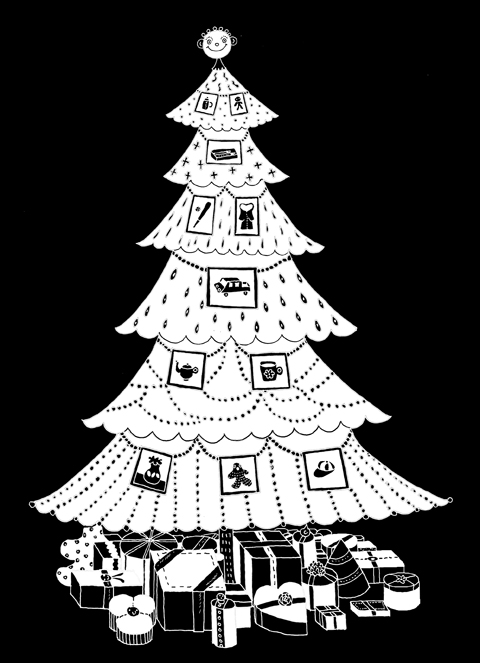Two Christmases ago, my 84-year-old grandmother gave me a pair of ostentatious clip-on earrings and a necklace. They were the kind of big, sparkly crystal adornments favored by old ladies, small girls and magpies and, though I loved my gran and tried the jewelry on in front of her, telling white lies about how much I liked it, I also planned to take it all to the nearest charity shop.
At the time, I was looking after a nine-year-old girl at weekends. I had already bought her Philip Pullman’s His Dark Materials book trilogy for Christmas, despite her preference for “games for my Nintendo DS.” Maybe, it suddenly struck me, giving her the jewelry would compensate for my lack of electronic generosity? It seemed so. When I handed over her gifts, the nine-year-old ignored the books, tore the paper off the rewrapped box and gazed at the jewels, resplendent in their faux-velvet casing.
“Wow!” she gasped, eyes wide. “These must have cost at least a million pounds!”

I decided it would be unfair to disabuse her of this notion.
“Mm,” I replied.
She beamed, asked me to do up the clasp on the necklace, then declared: “This is my best Christmas present ever!”
I felt warm and Christmassy inside. All was right with the world, as the nine-year-old paraded around in sparkling splendor. Granted, she forgot about the jewelry just weeks later and reiterated her request for Nintendo DS games, but that’s what nine-year-olds do.
Time went by, and soon it was spring. On a visit to my grandmother’s, I showed her a picture the girl had drawn.
“Bring her round,” she suggested, before starting to plan what she could feed us.
And so, a few months later, I arrived at the nine-year-old’s house, ready to take her to meet my grandmother. She came bounding down the stairs, wearing her best dress, patent leather shoes — and, for the first time in months, the jewelry I had given her at Christmas.
I gulped hard. This, I suddenly realized, was the peril of regifting. I suddenly felt less like a resourceful redistributor of unwanted goods and more like a fraudulent cheapskate who was about to sadden both a kindly old lady and a trusting small child. The latter would find out the gift hadn’t been a special million-pound purchase, while the former would discover that her carefully chosen present had been carelessly bestowed upon another.
There had to be a solution that would save everyone’s feelings — but what? If I asked the nine-year-old to take off the jewelry for no good reason, she would get suspicious and refuse. I couldn’t claim that my grandmother didn’t like jewelry, because she always wore at least four items — and if I said she didn’t like jewelry on children, the nine-year-old would definitely ask my grandmother why. My grandmother would reply that she didn’t mind at all — at which point, the nine-year-old would pull out the dreaded regift, explaining that “Ariane got this for me for Christmas.” And, despite being 84, my extremely astute gran would be bound to recognize the jewels.
It was a nightmare of potential awkwardness. I considered canceling the visit altogether before remembering that both the nine-year-old and my grandmother had been looking forward to it for months, and the latter was probably cooking samosas and chapatis right now as I wrestled with my conscience. Postponing and lying that I didn’t feel well enough would make me an even worse person.
I thought quickly. We had to pass my flat on the way to the bus stop.
“That jewelry looks really nice with that dress,” I began, “but I have some jewelry at home that looks even better.”
The nine-year-old looked intrigued.
“What’s it like?” she asked. “It’s newer and even more sparkly,” I said. “Tell you what, let’s go and get it.”
When the girl took off her earrings and necklace, I hid them round the back of a plant pot. The jewelry I replaced them with wasn’t really newer or more sparkly, but it had a novelty value that the three-month-old gift lacked.
That day, the nine-year-old and my grandmother got on famously, and even bonded over their love of big jewelry. Meanwhile, I learned a valuable lesson about the spirit of Christmas: Always regift your presents to someone who will never meet the giver.
Ariane Sherine is editor of The Atheist’s Guide to Christmas.
They did it again. For the whole world to see: an image of a Taiwan flag crushed by an industrial press, and the horrifying warning that “it’s closer than you think.” All with the seal of authenticity that only a reputable international media outlet can give. The Economist turned what looks like a pastiche of a poster for a grim horror movie into a truth everyone can digest, accept, and use to support exactly the opinion China wants you to have: It is over and done, Taiwan is doomed. Four years after inaccurately naming Taiwan the most dangerous place on

Wherever one looks, the United States is ceding ground to China. From foreign aid to foreign trade, and from reorganizations to organizational guidance, the Trump administration has embarked on a stunning effort to hobble itself in grappling with what his own secretary of state calls “the most potent and dangerous near-peer adversary this nation has ever confronted.” The problems start at the Department of State. Secretary of State Marco Rubio has asserted that “it’s not normal for the world to simply have a unipolar power” and that the world has returned to multipolarity, with “multi-great powers in different parts of the
President William Lai (賴清德) recently attended an event in Taipei marking the end of World War II in Europe, emphasizing in his speech: “Using force to invade another country is an unjust act and will ultimately fail.” In just a few words, he captured the core values of the postwar international order and reminded us again: History is not just for reflection, but serves as a warning for the present. From a broad historical perspective, his statement carries weight. For centuries, international relations operated under the law of the jungle — where the strong dominated and the weak were constrained. That
On the eve of the 80th anniversary of Victory in Europe (VE) Day, Chinese Nationalist Party (KMT) Chairman Eric Chu (朱立倫) made a statement that provoked unprecedented repudiations among the European diplomats in Taipei. Chu said during a KMT Central Standing Committee meeting that what President William Lai (賴清德) has been doing to the opposition is equivalent to what Adolf Hitler did in Nazi Germany, referencing ongoing investigations into the KMT’s alleged forgery of signatures used in recall petitions against Democratic Progressive Party legislators. In response, the German Institute Taipei posted a statement to express its “deep disappointment and concern”